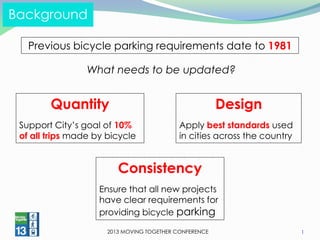
A Systematic Approach to Bicycle Parking Planning for Cities--Bike Parking Approaches Rosenblum
- 1. 2013 MOVING TOGETHER CONFERENCE 1 Background Previous bicycle parking requirements date to 1981 What needs to be updated? Quantity Support City’s goal of 10% of all trips made by bicycle Design Apply best standards used in cities across the country Consistency Ensure that all new projects have clear requirements for providing bicycle parking
- 2. 2013 MOVING TOGETHER CONFERENCE 2 Zoning Petition Overview Modify Definitions in Article 2.000 PARKING BICYCLES BICYCLE PARKING PARKING Current Zoning Definitions Proposed Zoning Definitions
- 3. 2013 MOVING TOGETHER CONFERENCE 3 Zoning Petition Overview 6.102 – General Terms and Standards Long-Term •secure •enclosed •for authorized users (employees, residents) Short-Term •available to the public •convenient to entrances •for everyone (customers, visitors)
- 4. 2013 MOVING TOGETHER CONFERENCE 4 Zoning Petition Overview 6.105 – Design and Layout Bicycle Racks Bicycle Lockers
- 5. 2013 MOVING TOGETHER CONFERENCE 5 Zoning Petition Overview 6.106 – Access Primary access: •5’ aisle width •5% ramp (or 8% with landings) •Elevator @ 80” by 54” Secondary access: •Garage ramps •Stairway channels NO OBSTRUCTIONS What’s wrong with this?
- 6. 2013 MOVING TOGETHER CONFERENCE 6 Zoning Petition Overview 6.107 – Quantity Use Type Long-Term (Minimum) Short-Term (Minimum) Residential Family Dwellings (at least 4 units) 1.00 space per dwelling unit for first 20 units 1.05 spaces per dwelling unit for additional units 0.10 space per dwelling unit Elderly or Group Housing 0.50 per living unit/bed 0.05 space per living unit/bed Hotel/Motel 0.02 per sleeping room 0.05 space per sleeping room Non-Residential Commercial Uses Range: 0.10 – 0.30 space per 1,000 SF (based on approx. 10% of expected employees) Range: 0.06 – 1.00 space per 1,000 SF (based on approx. 10% of expected visitors) College/University 0.20 space per 1,000 SF 0.40 space per 1,000 SF academic/administrative 1.00 space per 1,000 SF student activities K-12 School 0.30 space per classroom or 0.015 space per auditorium seat (greater of) 1.70 spaces per classroom or 0.085 space per auditorium seat (greater of) Note: Can shift some required long-term spaces to short- term (e.g., for small businesses)
- 7. 2013 MOVING TOGETHER CONFERENCE 7 Zoning Petition Overview 6.108 – Modifications by Special Permit Why allow modifications? New technologies/ideas Area-wide master planning Testing, monitoring may be needed Pooled bicycle parking strategies may be better in campus areas